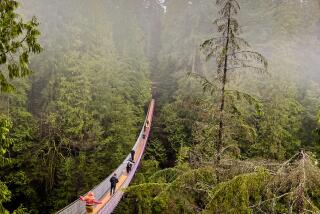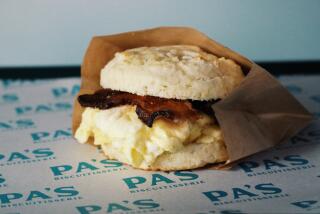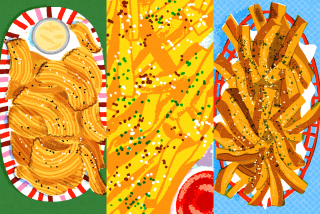Capital City of Tulips Is Canada’s Late Bloomer : Beautiful and civilized, Ottawa is one of the country’s best-kept secrets.
- Share via
OTTAWA, Canada — Ten-thousand tulip bulbs may seem like a lot to the back-yard gardener, but it’s a paltry number when considering the acres and acres of these lovely flowers that blanket Canada’s capital city every spring and early summer. They make it appear a radiant outpost of the Netherlands--which, in a sense, it is.
If you multiply the 10,000 bulbs the Dutch send Ottawa every year by the number of years since World War II, you’ll have an idea of Holland’s gratitude for Canadian favors during the war.
Dutch Queen Juliana, fleeing the havoc wrought by Hitler’s armies, took refuge in Ottawa and gave birth to Princess Margriet in a local hospital. The Canadians gave the queen’s hospital suite embassy status during her stay, making it officially Netherlands soil and protecting Margriet’s possible ascension to the Dutch throne. They also raised the Dutch flag over their parliament building for a day, the only time a foreign flag has flown there, and have been receiving the tulip bulbs yearly ever since.
Of Canada’s major cities, Ottawa is a latecomer. It was wilderness until 1800, when lumber and grain mills on the banks of the Ottawa River provided the economic basis for a new community. When Queen Victoria chose it as Canada’s capital in 1857, one disgruntled Toronto citizen called it “the nearest lumber village to the North Pole.” Others termed it “Westminster in the Wilderness,” some claiming that it was chosen because any invading army was sure to get lost in all that foliage.
And foliage it has, being surrounded by a green belt to remind one of the Vienna Woods, with inroads throughout the city. This greenery cuts through rainbow waves of tulips, lilac bushes the size of railroad boxcars, and flowering chestnut and crab-apple trees that line the town’s canals, boulevards and rivers.
Ottawa’s most important thoroughfare is the Rideau Canal, a man-made, five-mile strip of water that cuts through the heart of the city. One of the most fascinating sights of winter is to witness morning and evening rush hour on the canal, as executives and others skate to and from work downtown, briefcases in hand, ruddy faces swaddled against the sub-zero cold. Summertime is just as joyful on the canal, as small craft ply its waters and picnickers line its grassy banks.
Ottawans show little concern that some Canadians consider them staid government types. They’re too involved with year-round cultural events and festivals, 10 national museums and a host of smaller museums and galleries.
Ottawa’s Parliament Hill is surely the most impressive array of Gothic buildings anywhere in the Western Hemisphere. All in all, Ottawa is one of the most civilized and beautiful cities of our acquaintance. Yet it is for some strange reason one of Canada’s best-kept secrets.
Getting settled in: The Lord Elgin Hotel is in the heart of town. It’s a huge and very stately place, half a century old with more than 300 rooms. Dignified yet homey, the Elgin’s bedrooms are moderate in size and have all the comforts and conveniences one expects in a first-rate hotel. The Connaught is the hotel’s excellent restaurant.
Another fixture at mid-city, just four blocks from Parliament Hill, is the 19th-Century Hotel Roxborough. The lobby has been given a contemporary face lift since our last visit. Bedrooms are still spacious and have most big-hotel amenities. Lily’s Restaurant has a daily menu from different countries (Spain’s paella, Provencal lamb cutlets, Turkish shish kebab) for only $6.50, including the salad bar or soup.
Holiday Inn Market Square also has spacious bedrooms, many with balconies overlooking the central pool and patio, an inside bar-restaurant and two outdoor patios for dining--one overlooking the pool, the other facing a market scene.
Thanks to the favorable Canada-U.S. exchange rate, all three of the hotels mentioned above are marvelous values.
Regional food and drink: Ottawa has few dishes to call its own, but since it’s just across the river from Quebec Province, there are good French dishes to go with a respectable mix of other ethnic restaurants. A wonderful variety of fresh seafood is probably the city’s strongest suit.
One little winner indelibly associated with Ottawa is the beaver tail, made of whole-wheat or doughnut dough and for sale at street stands all over town. It’s about half the size of a baseball glove, not much thicker than an average pizza, and shaped roughly like the furry rascal’s broad tail. They’re deep fried and covered with anything from cream cheese and chives to brown sugar, cinnamon and lemon juice in the version known as a Killaloe Sunrise. Once you bite into one, you’re hooked.
Mixed opinions are held for poutine, French fries slurped with melted cheese and gravy; some claim it’s delectable while others insist it’s not fit for human consumption.
Sugar pie is made from maple syrup and is sort of a pecan pie without the pecans, or treacle with a crust. Ottawa Valley ale is a favorite with suds lovers hereabouts, and Canada’s wines from the Niagara-on-the-Lake region are excellent.
Good local dining: The Courtyard Restaurant (21 George St.) began life as a log tavern in 1827, became an inn of quarried stone a few years later, and is the most historic building in Ottawa. The Courtyard, which had its ups and downs during the past century, is now a delightful series of rooms hung with tapestries of historic scenes that resemble stained-glass windows in their brilliance.
Good starters here are a coquille de fruits de mer ($5) or the seafood chowder ($3.50). Main courses run the gamut from the house specialties of rack of lamb prepared with Dijon mustard ($16) to veal Oskar with crab meat at the same price, and fillet of sole stuffed with spinach and crab ($12.50).
Going first-class: Chateau Laurier is the grand dame of Ottawa hotels, an enormous French-Gothic place that matches the majesty of nearby Parliament Hill with its copper-roofed turrets and liberal use of Italian marble. It is such an integral part of Ottawa’s social and political fiber that it has often been called Canada’s “third house of Parliament.” Bedrooms and suites are regal. There’s an indoor pool and health club, Peacock Alley for shopping, two fine restaurants and an upscale bar-lounge.
On your own: Ottawa is up to its ears in culture, and two of Canada’s most glorious museums have opened since our last visit. The National Gallery of Canada is an architectural tour de force that will surprise anyone with the breadth and quality of its collections: Old Masters such as Rubens, Rembrandt, Van Dyck, Hans Memling and El Greco.
By all means, make plenty of time for strolling the shops of Byward Market, a glorious display of vegetables, fruits, flowers and shops since its opening in 1846. And plan on a cruise down the Rideau Canal with a tour operator or in a self-propelled small craft.
GUIDEBOOK
On the Way to Ottawa
Getting there: From Los Angeles, Air Canada, Canadian Airlines and Delta offer service to Ottawa. Air Canada’s advance-purchase, round-trip fare, with a stop in Toronto, is $415.
A few fast facts: Canada’s dollar was recently worth 83 cents, making for plenty of bargains up there.
Where to stay: Lord Elgin Hotel (100 Elgin St., telephone 800-267-4298; $62 double, $55 weekends); Hotel Roxborough (123 Metcalfe St., tel. 613- 237-5171; $83 double B&B;, $44 weekends); Holiday Inn Market Square (350 Dalhousie St., tel. 800-HOLIDAY; $75-$83 double, $55 weekends); Chateau Laurier (1 Rideau St., tel. 800-828-7447; $86 double, $73 until April 30).
For more information: Call the Ottawa Tourist Office at (800) 465-1867, or write (111 Lisgar St., Ottawa K2P 2L7, Canada) for a 178-page visitors guide listing accommodations, dining, cultural attractions and entertainment, including city maps. Also ask for information on Tulip Month (April 30-May 6), with its many events, including a flotilla of flower-decked boats on Rideau Canal. The 41st annual Canadian Tulip Festival (May 20-24) offers daily attractions; call (800) 66-TULIP for information.
More to Read
Sign up for The Wild
We’ll help you find the best places to hike, bike and run, as well as the perfect silent spots for meditation and yoga.
You may occasionally receive promotional content from the Los Angeles Times.






